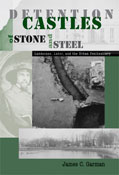Detention Castles of Stone and Steel
Landscape, Labor, and the Urban Penitentiary

- Author(s): Garman, James C.
- Series:
- Imprint: Univ Tennessee Press
- Publication Date: 0000-00-00
- Status: Active
- Available in Hardcover - Cloth: Price $37.00 | Buy Now
“Garman’s research stands out as the most interesting and insightful archaeologicalanalysis of an institution that I have read.” -Randall McGuire, Binghamton University
The advent of the Enlightenment ignited many changes in the philosophical landscape of both the young American republic and its European counterparts. Among the new ideals propagated was the notion of reforming society’s deviants. Contrary to the long-held view that the purpose of the prison was primarily punishment, a new and more optimistic mindset regarded prison as the principal agent of social and moral reform. Consequently, the 1830s saw a number of states and territories construct prisons dedicated to this new correctional ideology. One such state was Rhode Island.
In Detention Castles of Stone and Steel, James C. Garman conducts an in-depth study of the history of the first Rhode Island State Prison. Based on extensive archaeological excavations and a rich trove of historical documents, Garman gives a searching account of how a well-intentioned effort by Rhode Island to reform its prison population turned into a spectacular boondoggle. Indeed, the state’s supposed prison of the future was only in operation for forty years: from 1838 to 1878.
Garman looks at the prison landscape, the changing labor regime, and the contested notion of discipline in the Rhode Island State Prison. Garman also seeks to answer why this project failed to accomplish its purpose of serving as a beacon of reform. Detention Castles of Stone and Steel uncovers a variety of reasons for the prison’s failure to live up to its noble ideals. A large measure of the problem rested, according to Garman, with ambiguous intent, legislative indifference, and the drive to make the prison a source of profit, as well as a site for reform, for the state.
This book will be of great interest to anyone who is interested in historical archaeology, nineteenth-century history, and social history.
